Suffragette: a women in the early 20th century who, advocated for “Votes for Women”.
Last year the UK celebrated the anniversary of British women getting the right to vote. It was also the year that Dr. Sumita Mukherjee published her book Indian Suffragettes: Female Identities and Transnational Networks. Dr. Mukherjee highlights the involvement of Indian women in suffrage movements around the world during the imperial era and its transnational nature.

On 13th September 2018, I attended a talk with Mukherjee at the East End Women’s Museum and Tower Hamlets Local History Library Archives in London. At the talk, I realised that throughout my school education I was extensively taught about British women’s suffrage. However, the contribution of Indian women, or any women of colour, was almost always left out of the conversation.
As the Representation of People Act 1918 granted women above the age of 30 with property to vote; the contribution of working-class women and especially women of colour were unacknowledged, unheard and unspoken. It is evident from photographs that Indian women were very much a part of the British Suffrage movement. However, they cease to exist in British history or culture. For example, the 2015 film Suffragette gained much criticism, for being “guilty of a cinematic whitewash” says Anita Anand.
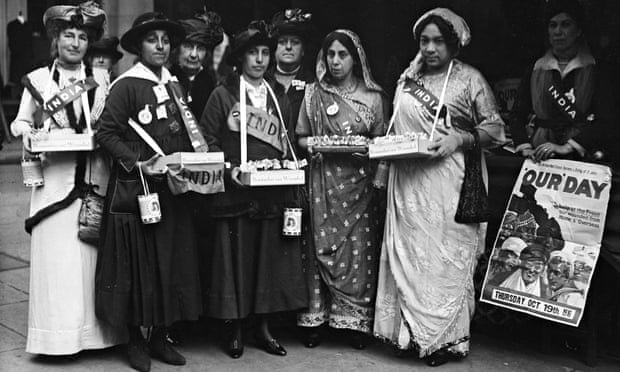
During the early 1900s the British suffrage movement was moving fast, attracting the attention of the Indians living in Britain. There were only a few women of colour in the British suffrage movement. However, some were not credited as active participants that were included in the conversations and debates regarding women’s rights. Deep-rooted in the ideas of race, empire, and colonialism, often the participation of Indian women were objectified as they were encouraged to wear Sarees for the suffrage processions.
There were only a few women of colour in the British suffrage movement. However, some were not credited as active participants that were included in the conversations and debates regarding women’s rights.
The suffrage movement for India women was not just merely about overcoming patriarchy and patriarchal norms but intersected with the call for independence against British colonial rule. Due to this at times the role of Indian women was relegated to the background in Britain and deemed softer protests – secondary to the movements led by men in India. The British suffrage movement and the Indian suffrage movement are inextricably interrelated through Empire.
Also read: A Brief Summary Of The First Wave Of Feminism
Many of the Indian women participants of the British suffrage movement, recognised that to gain independence and further the women’s suffrage in India, they must first help the women of the Empire. Here are some but not all the Indian Women who brought about change for women in Britain and India:
1. Princess Sophia Duleep Singh
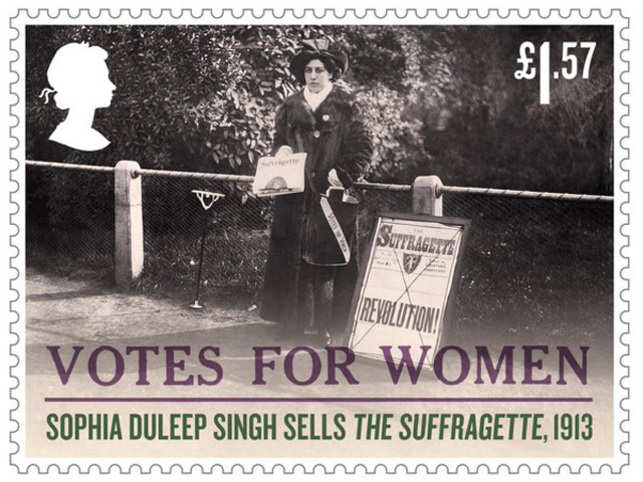
Princess Sophia Duleep Singh was the daughter of the exiled Indian Prince Maharaja Duleep Singh and goddaughter of Queen Victoria. Mukherjee explains that she “was the most active and prominent non-white British suffragette” of Indian heritage in the movement. Sophia joined the WSPU in 1909, and she was an active part of the Women’s Tax Resistance League which argued that women should not have to pay taxes as they do not have the vote.
Sophia was often able to refuse to pay taxes due to her aristocratic background, unlike other Indians living in Britain. Nevertheless, she did not let the concerns of elite British society diminish her spirit, as can be seen from the image above where she is passing out the WSPU’s weekly newspaper called The Suffragette near her residence, Hampton Court Palace.
2. Madam Bhikaji Cama
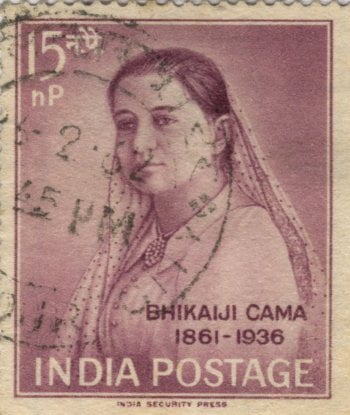
Madam Bhikaji Cama’s inclusion in this list can be contested as she was an ardent Indian nationalist and her activism was less interested in Britain and more on the independence of India. She played an important role towards India’s freedom struggle and women gaining equality. She stressed the importance of women in building a nation. She was the first person to unfold the tricolour Indian flag in 1907 at the International Socialist Congress, in Stuttgart, Germany. In 1909 she published a journal called Bande Mataram from Paris.
Due to her participation in nationalist activities, she was prohibited from returning from her stay in London by the British unless she refrained from continuing these activities in India. Cama then relocated to Paris and founded the Paris India Society. She would secretly send weekly magazines to Indian revolutionaries and support them in any way she could; financially, through her writings and ideas.
3. Lolita Roy

Lolita Roy was one of the Indian women under the India flag at The Empire Pageant procession in 17th June 1911 March that has been identified. Roy was from Calcutta and was married to Piera Lal Roy who was an Indian barrister, and the couple had six children. She became president of the London Indian Union Society in 1910 and begun playing an influential role in the Indian section of the female suffrage movement. The Roy’s relocated to London where Roy was quite actively involved in the British suffrage movement and for the empowerment of Indian women.
Roy was described as “one of the most emancipated of Indian women”, in The Vote, a women’s newspaper on 17th June 1911.
Roy was described as “one of the most emancipated of Indian women”, in The Vote, a women’s newspaper on 17th June 1911. She was a member of the ‘Eastern League’, set up by both Indian and British women to raise money for the Indian Soldiers’ Fund. The image above is a commemoration of her contribution as part of British suffragette Millicent Fawcett’s statue in Parliament Square, London.
4. Shrimati Sushama Sen
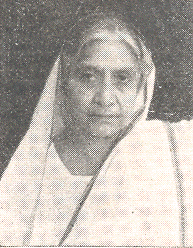
Shrimati Sushama Sen participated in the WSPU demonstration in 1910. At the time “there were few Indian women in London” and she had been invited to join the demonstration” led by Pankhurst to the Parliament House” where she was the “subject of public gaze”, Sen notes in her book Memoirs of an Octogenarian(1971). In 1952 she was elected as a member of the first Lok Sabha for Bhagalpur South (Bihar). She was 1 of 22 to have a seat opposed to 467 seats for men.
5. Cornelia Sorabji

Cornelia Sorabji was the first women to graduate from Bombay University, to study Law at Oxford University and to practice law in India and Britain. She was not a direct participant of the suffrage movement, however, she has advocated for women to get the vote and for women rights. From as early as 1902 she petitioned to the India Office to allow women to practice law and for women and minors to have female representation in courts.
In 1923 women were allowed to practice law and from 1924 it is said that she had represented over 600 women and minors sometimes at no cost. She was involved with the Hackney branch of the Women’s Freedom. She is indicative of the advancement of women’s suffrage from a time before it began in Briain – the Women’s Freedom League. A statue of her bust is at The Honourable Society of Lincoln’s Inn.
6. Bhagmati Bhola Nauth
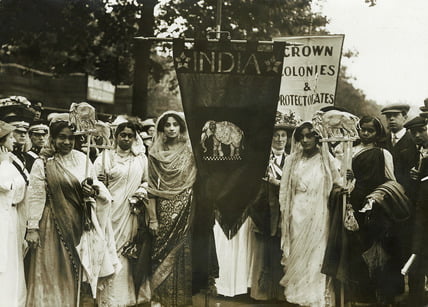
Bhagwati Bhola Nauth is one of the women identified in the picture above, alongside Lolita Roy and her daughter Leilavati Mukherjee. Although she had no occupation, she was the honorary secretary of the Indian Women’s Educational Fund. Nauth was also a member of the ‘Eastern League’, alongside Lolita Roy.
7. Ramdhulari Devi
Ramdhulari Dube spoke about the progress of Indian women at the Women’s Freedom League ‘International Fair’ in November 1912 at the Chelsea Town Hall. As a member of the league, she was recalled as “showing the ability and charm of an Indian woman – and the picturesqueness of her dress”.
These are only a few of the names of Indian suffragettes and feminists; there are more mentioned in Mukherjee’s book and many more that have either been erased from history or yet to be found. Despite being under colonial rule, Indian women sought to engage with suffrage movements for Indian’s living in India and overseas.
Their strife in fighting to empower Indian women was linked to Britain primarily due to empire and the power politics involved. However, the desire for equal rights began way before suffrage movements of the West. It was not British women nor the empire that ‘saved’ or ’emancipated’ Indian women, but the determination and hard work of Indian women themselves. As Mukherjee states, “It is through their travel, correspondence, petitioning, marching, and publishing that a range of Indian suffragettes were able to ensure that Indian women’s rights were not overlooked either in India or other parts of the world.”
Also read: International (Working) Women’s Day: A History Of 8th March
The link between British women’s suffrage and Indian women’s suffrage is most apparent due to Britain colonialism; however, Indian women the activism of Indian women also spread to colonies worldwide.
Reference
1. Burton, Antoinette. Burdens of History: British Feminists, Indian Women, and Imperial Culture, 1865-1915. University of Carolina Press, 2000.
2. Mukherjee, Sumita. Indian Suffragettes: Female Identities and Transnational Networks. London: Oxford University Press, 2018.
Note: The movement began during British Colonialism. Thus, Indian women also encapsulate Pakistani and Bangladeshi women.
Featured Image Source: The British Library
About the author(s)
Nikhat is a Civil Servant and Communications Manager for BBPC Poetry Collective. Her academic research interests include wartime gender-based violence and intersectional feminist historiography.





